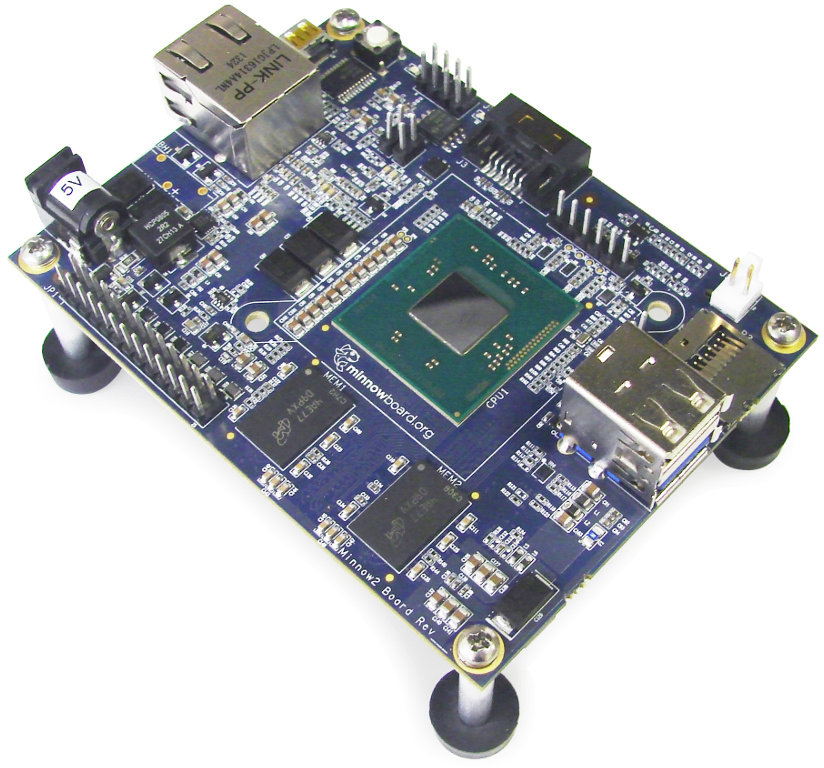When Intel released the original MinnowBoard which was a step in the right direction, but there were some complains, as the company had chosen to use an older Intel processor, and the price was much higher than most high performance low cost ARM development boards. MinnowBoard MAX (aka Minnow2 Board) fixes all that, as it features the latest Intel Bay Trail-I (E3800 series) processor, and costs as low as $99 for the single core version, and $129 for the dual core version.

Let’s jump directly to the specifications:
- SoC – 64-bit Intel Atom E3815 (single-core, 1.46 GHz) or Atom E3825 (dual-core, 1.33 GHz) both with integrated Intel HD Graphics coming with Open Source hardware-accelerated drivers for Linux OS
- System Memory – 1GB ($99 model) or 2GB ($129 model) DDR3 RAM
- Storage – 1x Micro SD card slot, 1x SATA2 3Gb/sec, 8 MB SPI Flash for firmware (UEFI)
- Video Output – micro HDMI connector
- Audio Output
- HDMI (digital)
- Analog audio to become available via a separate Lure, the name for MinnowBoard expansion boards, which will be sold separately –
- Connectivity – 10/100/1000M Ethernet RJ-45 connector
- USB – 1x USB 3.0 host, 1x USB 2.0 host
- Debugging & Programming – Serial debug via FTDI cable (sold separately), programming header compatible with Dedi-Prog programmer, and JTAG via high-speed expansion port.
- Expansion headers
- Low-speed expansion port – 2×13 (26-pin) male 0.1″ pin header with access to SPI, I2C, I2S Audio, 2x UARTs (TTL-level), 8x GPIO (including 2x supporting PWM), +5V, and GND
- High-speed expansion port – 60-pin, high-density connector with access to 1x PCIe Gen 2.0 Lane, 1x SATA2 3Gb/sec, 1x USB 2.0 host, I2C, GPIO, JTAG, +5V, and GND
- Dimensions – 99 x 74mm
- Temperature Range – 0 – 70 deg C. Industrial temperature range may also be also available, but price will be higher, and has not been disclosed.
- Power – 5V DC (Sold separately)
The board will run Debian GNU/Linux, Android 4.4 Kitkat, and be supported by the Yocto Project. It will boot with UEFI firmware stored in the 8MB SPI flash. The specifications also mention Intel HD graphics will be supported in Linux with open source graphics drivers, something that’s almost impossible to find for ARM development boards, although there has been some progress recently with the Raspberry Pi and Nvidia Tegra K1. It will be an open source hardware board, and design files will be made available under Creative Commons licensing within weeks of production boards being available at distributors.
MinnowBoard MAX competes directly with quad core ARM Cortex A9 development board such as HardKernel ODROID, Wandboard, and so on, that sells for about the same price. We’ll need to check benchmarks to get a better idea of the performance.
The boards are scheduled to be manufactured by CircuitCo by the end of June 2014. You can’t pre-order them just yet, and they will be available through various distributors. if you happen to be in EE Live! in San Jose, you can see a working demo with MinnowBoard MAX on booth #916.

Jean-Luc started CNX Software in 2010 as a part-time endeavor, before quitting his job as a software engineering manager, and starting to write daily news, and reviews full time later in 2011.
Support CNX Software! Donate via cryptocurrencies, become a Patron on Patreon, or purchase goods on Amazon or Aliexpress




